The concepts covered in this fact sheet go beyond those seen in high school. It is intended as a supplement for those who are curious to learn more.
The city of Baghdad, like most of the major cities that flourished in the Middle Ages, was located close to the trade routes of the time. Baghdad lies on the banks of the Tigris, the river that links Mesopotamia to the Persian Gulf. The Tigris and a second river, the Euphrates, flowing some 30 kilometers from the Tigris, both ensured good irrigation of farmland in the Baghdad region.
The Baghdad region was then a vast irrigated plain, with the two rivers providing natural protection against enemy attacks, as well as being a major asset for transport and trade. Not only did the rivers facilitate the transport of goods, but Baghdad straddled two trading continents: Europe and Asia. It was therefore perfectly situated to become a major commercial crossroads.
More precisely, Baghdad's North-South axis provided connections between Mesopotamia and the Persian Gulf, the South-West-North-East axis linked the holy cities near Palestine with the Iranian plateau, while the South-East-North-West axis ensured trade between Syria and the Iranian Gulf.
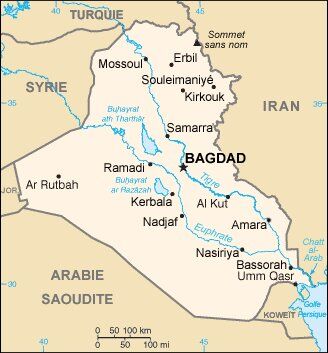
Map of Baghdad's location.
Note : An image in English is coming soon.
Baghdad's geographical location gave it a threefold advantage: easy agriculture thanks to irrigated land, easy trade thanks to rivers, and military protection thanks to those same rivers.
Before becoming the capital of the Arab Empire, Baghdad was a small town on the banks of the Tigris. The city already benefited from the fertile plain and natural protection offered by the two rivers. Although still modest in size, Baghdad already hosted trade fairs.
The Arab Empire was emerging from a more difficult period in which foreign conquests were running out of steam and tensions between different ethnic and religious groups were on the rise. The Abbasid caliphate began with a break with Greek and Byzantine traditions.
The new caliph, al-Mansur, wanted to move the center of power to Iraq and was looking for a new city to establish his residence and capital. According to legend, he traveled all over Iraq looking for the perfect location. In 762, he founded his new capital on the site of Baghdad. He renamed the city Madinat al Salam, meaning “City of Peace”. However, the population continued to call it Baghdad. The caliph had chosen this location in view of the many possibilities offered by the rivers and fertile plain. He also appreciated the cool nights and absence of mosquitoes. Al Mansur wanted to see the world's most flourishing city develop here.
To begin construction of his new capital, Al Mansur hired the most renowned astronomers and skilled craftsmen in the entire empire. As soon as it was built, Madinat al Salam announced itself as a grandiose city.
The city's layout was perfectly circular, designed to facilitate city administration and commerce. This immense circle had a diameter of four kilometers and was surrounded by a 20-meter-wide moat and two immense stone walls. The first was 17 metres high and five metres thick, while the second was 14 metres high and 4 metres wide. Four gates provided access to the city. To better control entry and exit, sentries guarded the gates at all times.
The center of the Round City was occupied by a large mosque and the Caliph's palace. The palace was topped by an immense green dome measuring over 48 meters in height. Richly decorated and surmounted by a statue, this dome impressed all visitors to the city. In fact, it is the descriptions given by some visitors that enable us to describe it today. In fact, the dome was destroyed when lightning struck it.
From the center, four avenues led to the gates. Around the palace and the mosque were the residences of the court officers and the administrative offices. All the buildings were constructed in brick, the traditional material of Baghdad and the region.
Most of the Round City was destroyed in a war of succession in 812-813. Only the mosque was spared from attack. Subsequent caliphs then had to rebuild part of the city. The palace was rebuilt outside the city walls, on the east bank of the Tigris. The new buildings were designed with great attention to decoration and aesthetics: numerous pavilions, columns, gardens, streams, lawns, water features, zoological gardens, hunting grounds, etc.
The “city of peace” continued to grow and attract new inhabitants. Such was the growth that by the end of the 8th century, markets had to be held outside the city walls. The caliph also ordered the construction of a second mosque to free up space in the heart of the city.
In just a few decades, Baghdad was already a flourishing capital, with housing extending beyond the walls. The caliph himself had built a palace with terraces outside the city walls, where he led a life of luxury. Indeed, as time went by, the ruling caliphs adopted a luxurious lifestyle and an attitude that distanced them from the people. When they addressed the population, they always did so hidden behind a silk curtain. The caliphs had the right of life or death over any townspeople who managed to speak to him. In 786, Haroun al Rachid became the new caliph. It was at this time that Arab civilization underwent a renaissance that Europe would not experience until the 15th and 16th centuries.
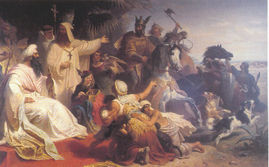
Canvas depicting the Caliph al Rashid receiving a delegation from Charlemagne
Indeed, under the rule of al Rashid, Arab civilization experienced an unprecedented cultural, intellectual and artistic boom, which reached its apogee throughout the 9th century. This boom would probably not have had the same importance without the contribution of Caliph al Ma'mun, who ruled between 813 and 833. This sovereign reintroduced philosophy, science and mathematics from Greek texts. He encouraged intellectuals to take as much interest in these as in Persian and Indian texts, which also reached Baghdad. The knowledge of the Arabs of the time was a synthesis of Eastern and Western cultures.
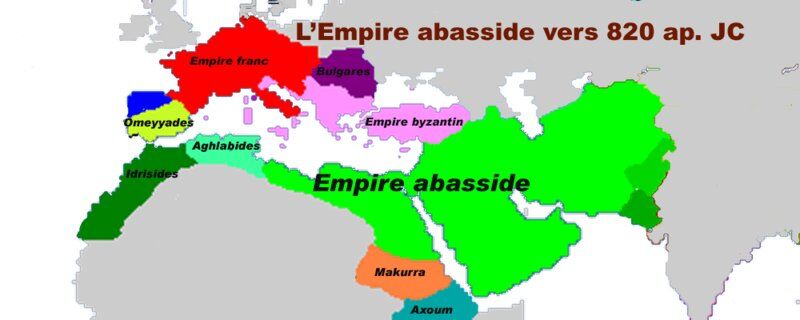
The extent of the Abbasid empire under the reign of al Ma'Mun.
Note : An image in English is coming soon.
With the founding of the House of Wisdom, intellectuals had a gathering place where they could exchange, translate and reflect. The establishment's library contained some 10,000 books.
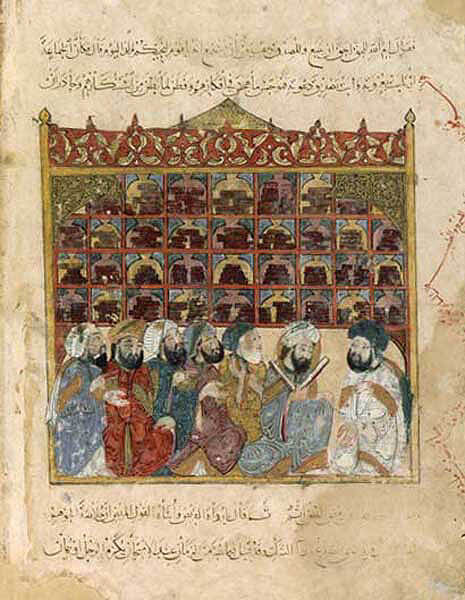
Study in a period library.
At the same time, specialized artistic disciplines were developing and gaining in importance. Such was the case with calligraphy, whose works became invaluable and whose creators enjoyed a high social status. The same was true of illumination, which developed in books and decorated editions of the Koran.
Several paper mills were also set up, which greatly contributed to the layout and distribution of books throughout the empire. These books dealt with medicine, science, astronomy and zoology, and were virtually all illustrated. It was during this period that the tales of the Thousand and One Nights were written.
Medical science underwent the same major development as literature. With the opening of the first hospitals, some of which specialized in the treatment of madness, Arab medicine was well ahead of other civilizations. In fact, Avicenna was the greatest physician of his time: he wrote several texts describing diseases and their symptoms in detail, and wrote a medical encyclopedia.
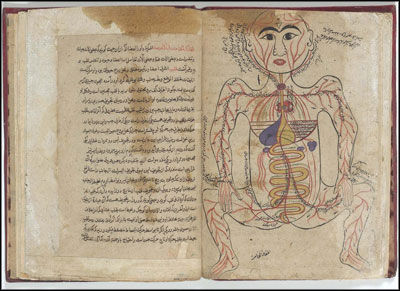
One of Avicenna's illustrated treatises (the Canon)
The techniques used in those days were very precise. Based on the observation of symptoms and the search for causes, Arab physicians treated more effectively than Western doctors. Physicians were committed to respecting the rules of the profession, as well as hygienic standards that prevented the spread of contagious diseases. They also used effective pharmaceutical products to treat illnesses.
Great innovations also enriched the fields of science, technology and mathematics. These innovations led Baghdad to set up an efficient, structured water supply, irrigation and air-conditioning system.
The rise of the Arab Empire meant that Mediterranean and Asian trade moved to Baghdad. The geographical location and quantity of goods passing through Baghdad justified this shift.
All the rare products of Asia and the West passed through Baghdad. The Baghdad trade brought together those of Central Asia, North Africa, the Mediterranean, Spain, the Far East, India, China, Indonesia, the Persian Gulf and the Red Sea.
The goods were as follows:
Silks, ink, peacocks, porcelain, saddles, spices (from China);
Rubies, silver, sandalwood, coconuts, ivory, dyes (from India);
Cereals and cotton (from Egypt);
Glassware and fruit (from Syria);
Silk and textiles (from Persia);
Slaves, ivory and gold (from Africa);
Drugs and jewelry (from Byzantium);
Leather (from Spain);
Furs, swords, amber (from Russia and Scandinavia).
The presence of all these luxury goods in the city stimulated craftsmanship. Many craftsmen began to make similar products, or to make various objects from them.
The presence of these effects in Baghdad also changed certain habits of life. For example, Persian-inspired games gained in popularity, Arabs tasted exotic foods, used rags and porcelain, furnished their homes differently, dressed in pants and so on.
All these products contributed to increasing Baghdad's wealth. New institutions were created at this time to facilitate trade. Banks made their appearance at this time. Their purpose was to facilitate the conversion of different currencies, and to exchange cheques and letters of credit.
It was during this boom in commerce, arts and sciences that Baghdad experienced its greatest effervescence. The population even surpassed one million in the 10th century. Several houses were built outside the walls to accommodate all these people.
Although it never really lost all its glory and wealth, the city of Baghdad was considerably weakened by the second half of the 10th century. Tensions between Shiites and Sunnis were beginning to affect the city's administration. The authorities also had to deal with internal troubles such as the revolts of the black slaves, nicknamed the Zandjs. The latter were mainly used to grow sugar cane.
Several foreign states were detrimental to the Arab Empire. First, the Mongols invaded. Later, Turkish guards seized power, leaving only symbolic power to the caliph. The city was plundered and fought over. Baghdad had never been so weakened politically or militarily.
At the same time, trade routes were shifting. The land route went further north, while the sea route went further west. Baghdad was no longer the commercial crossroads through which all goods passed, and this diminished the economic power of the capital of the Arab Empire.
At the beginning of the 11th century, intellectual decline began following a decision by the caliph: it became forbidden to propose new interpretations of the Koran. This decision put an end to an era when critical thinking was highly developed and encouraged intellectuals to research and reflect on the world. From then on, intellectual and scientific innovation ceased to flourish. In 1256, civil war broke out in Baghdad, weakening the city and its defenses.
By November 1257, three armies were heading for Baghdad. The two Mongol armies, assisted by the Christian army, then began attacking Baghdad. For months, the city was bombarded with stones, fire, crossbows and arrows. Attacks continued day and night.
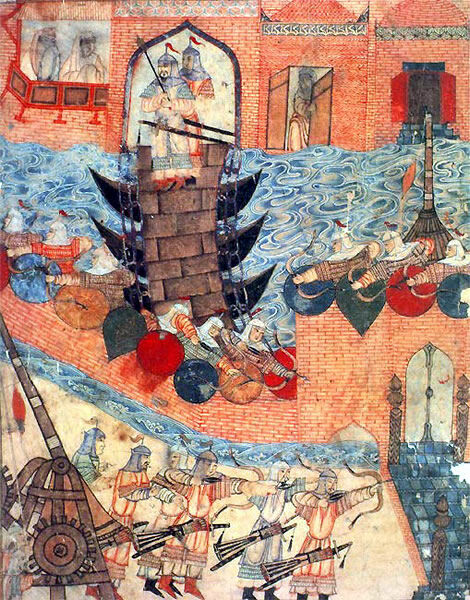
Baghdad under siege in 1258.
Baghdad resisted attack until January 17, 1258. The next day, the Mongols entered the city and seized the fortifications. The population was massacred, the caliph was executed, and the city looted, destroyed and burned. This attack put an end to the golden age of Baghdad and the Arab Empire. From then on, there was a great recession, which put an end to the economy and demographic development.
Several other peoples then tried to take control of Baghdad. The Turks succeeded in 1401. Subsequently, throughout the 16th century, the city was an important stake for the Ottomans, who took over the commercial relay. Today, Baghdad is the capital of Iraq, an independent country since 1930.
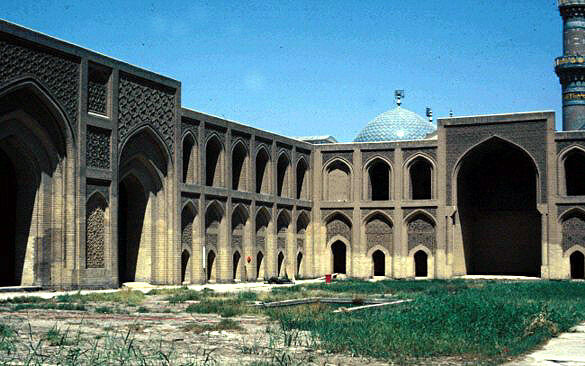
La Madrasas Mustansiriya.
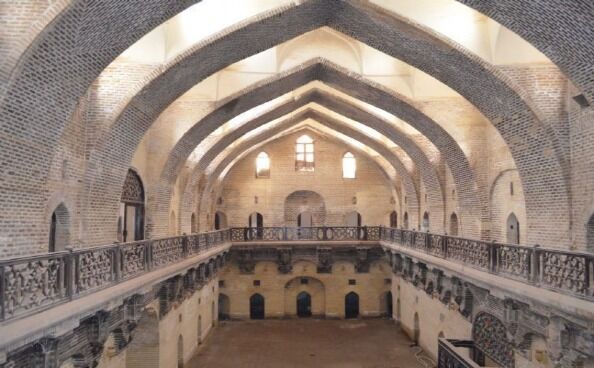
The caravansérail Khan Murjan.
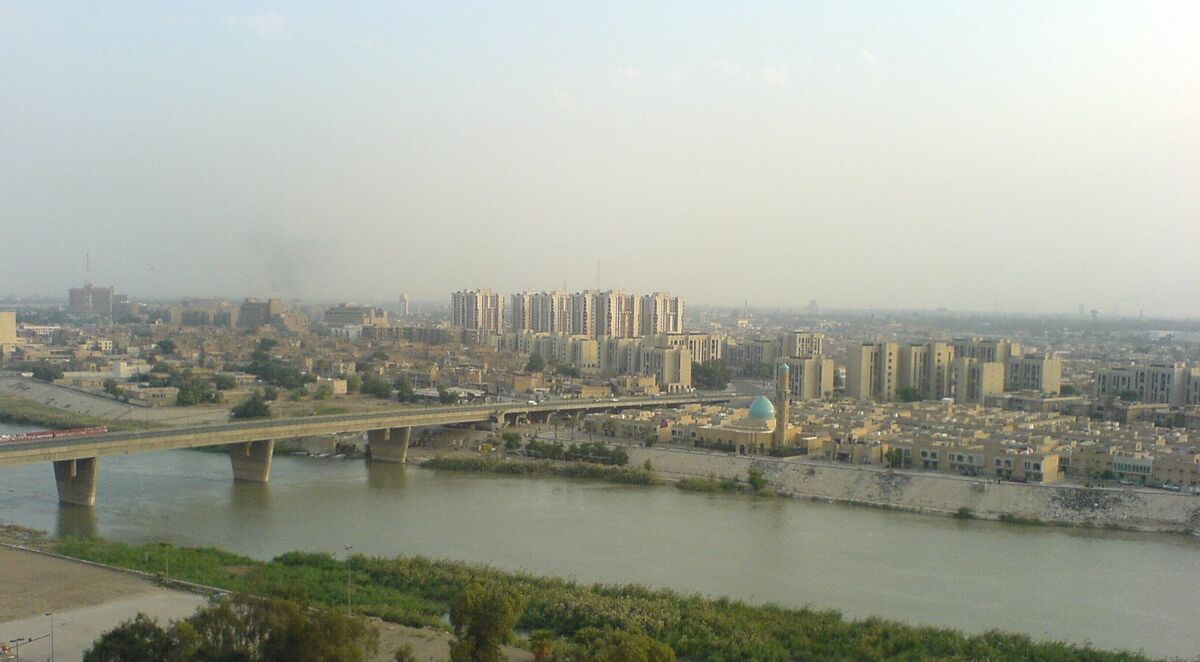
Baghdad in contemporary times.
A few surviving buildings are reminders of the years of wealth that Baghdad enjoyed throughout its history. These include the Abbasid Palace, built in the 12th century, the Mustansiriya Madrasas and the Khan Murjan caravanserai, built in the 14th century.